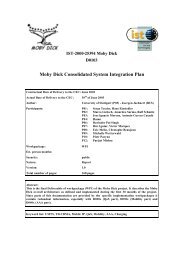IST-2000-25394 Moby Dick D0601 Dissemination and Use Plan
IST-2000-25394 Moby Dick D0601 Dissemination and Use Plan
IST-2000-25394 Moby Dick D0601 Dissemination and Use Plan
Create successful ePaper yourself
Turn your PDF publications into a flip-book with our unique Google optimized e-Paper software.
Fifth Framework Project <strong>25394</strong><br />
Public<br />
<strong>Dissemination</strong> <strong>and</strong> <strong>Use</strong> <strong>Plan</strong><br />
offered by using IP over a common core of routers, with three access technologiesrespectively<br />
Ethernet, IEEE 802.11 <strong>and</strong> W-CDMA (Wideb<strong>and</strong> Code Division Multiple<br />
Access), will allow operators to offer a common look <strong>and</strong> feel to services accessed from<br />
anywhere at anytime. Finally, <strong>Moby</strong><strong>Dick</strong> will provide support for new, mobile-aware,<br />
applications. Thus, when browsers are started they will be given location information <strong>and</strong><br />
users can then be provided with location-relevant information. This will be tested with<br />
ERASMUS exchange students. During their stay in the foreign university (either in Berlin or<br />
Stuttgart), students from Madrid can have audio access to lectures inhome university or to<br />
Web-servers in their home country with specific information.<br />
Operators will be able to exploit <strong>Moby</strong><strong>Dick</strong> to reduce costs for mobile communications.<br />
Additionally, they will be able to develop cost models <strong>and</strong> billing mechanisms for mobile IP<br />
QoS traffic. With the use of AAA architecture, they can set-up secure interconnection for<br />
business cases.<br />
3.1.4 Universities/Research Center’s View Point<br />
Universities will exploit <strong>Moby</strong><strong>Dick</strong> through an increase in know-how <strong>and</strong> ability to support<br />
the European mobile telecommunications industry. At the conclusion of the Project they will<br />
be in a strong position to supply technical support <strong>and</strong> trained engineers to the European<br />
work force in mobile telecommunications.<br />
Research Centers within the Consortium will be in a position to support the migration of<br />
operators from second generation systems to UMTS <strong>and</strong> <strong>Moby</strong><strong>Dick</strong>-based IP architects<br />
supporting mobile multimedia delivery. They will create competencies to support industrial<br />
partners <strong>and</strong> SMEs (Small <strong>and</strong> Medium Enterprise). Through liaison with bodies, such as<br />
3GPP, it is expected that early exploitation will be seen in the form of acceleration of the<br />
introduction of new services, even on updated second (e.g., GPRS, General Packet Radio<br />
System) <strong>and</strong> third generation networks.<br />
The project <strong>Moby</strong><strong>Dick</strong> will have a strong impact on further research <strong>and</strong> education of the<br />
computer scientist, telecommunications engineer, <strong>and</strong> electrical engineer of tomorrow.<br />
3.2 Individual Partner Strategies<br />
Based on these overall <strong>Moby</strong><strong>Dick</strong>-relevant discussion of opportunities <strong>and</strong> challenges,<br />
each individual partner of the <strong>Moby</strong><strong>Dick</strong> consortium expresses separately <strong>and</strong> explicitly<br />
their business or academic use plan.<br />
3.2.1 T-Nova, Deutsche Telekom Innovationsgesellschaft mbH, Berlin, D<br />
T-Nova is Deutsche Telekom’s research <strong>and</strong> development unit that focuses on creating,<br />
developing, testing, <strong>and</strong> introducing innovative products, services, networks/networkelements<br />
in the area of telecommunications <strong>and</strong> information technology. In addition T-Nova<br />
develops software <strong>and</strong> information systems for the support of the business process of the<br />
whole group of companies of Deutsche Telekom AG. T-Nova was founded in spring 1999 in<br />
order to join all research groups/subsidiaries <strong>and</strong> to strengthen the innovative potential of<br />
Deutsche Telekom AG. Beside several centers for the development of software <strong>and</strong><br />
information systems T-Nova has also integrated the well-known research centers<br />
“Technologiezentrum Darmstadt” <strong>and</strong> “Deutsche Telekom Berkom”.<br />
T-Nova have experience in all stages of project development from the management of large<br />
multi-national R&D projects through identification, definition, <strong>and</strong> implementation of the<br />
specific need of the business lines. In the area of mobile wireless communications, the<br />
Version 1.0 Page 11 of 40<br />
© Copyright 2001, the Members of the <strong>Moby</strong><strong>Dick</strong> Consortium
















